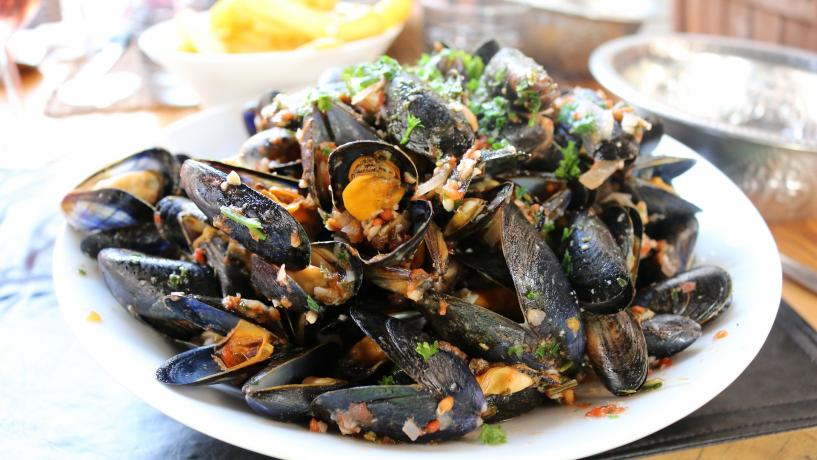
Australians have a big appetite for seafood, consuming roughly 345,000 tonnes of edible seafood products per year. Seafood, such as fish and shellfish, are good sources of protein, Omega-3 fatty acids and other essential nutrients that make it a healthy choice as part of a balanced diet.
However, as with any other type of food, it’s important to handle seafood safely to prevent food-borne illness. It’s especially important if you work in a restaurant, food retail business, child or aged care facility or any other business or organisation that serves food to the public.
To protect the people you serve from food-borne illness, follow these safe handling tips for buying, storing and preparing fish and shellfish.
How to buy seafood
FISH
Always purchase seafood from a registered seafood supplier and check that it is fresh, shows no signs of spoilage and is displayed or delivered at a safe temperature (5°C or below).
When buying or accepting a fish delivery, check to ensure that:
- it smells fresh and mild
- its eyes are clear and shiny
- the flesh is firm and springs back when pressed
- it doesn't have any strong odours (“fishy”, sour or rancid)
- it isn't discoloured, dark or dry around the edges
Note: Fresh fish and fish fillets sold as “previously frozen” may not have all the characteristics of fresh fish, but they should still smell fresh and mild. Reject any previously frozen fish that smells fishy, sour or rancid.
SHELLFISH
Never buy or prepare dead shellfish. Shellfish spoil rapidly after death, which increases the risk of microbial contamination, food poisoning, infectious diseases and other health problems.
When selecting shellfish, be sure to do the following:
- Discard cracked or broken bivalves — throw away clams, oysters, and mussels if their shells are cracked or broken.
- If shells are open, do a “tap test” — live clams, oysters, and mussels will close when the shell is tapped.
- Check for leg movement — live crabs and lobsters should show some leg movement.
How to store seafood
Store seafood:
- in the refrigerator at 5°C or below
- in the freezer at -15°C or below
If your business keeps live seafood in tanks, make sure the tanks are well-maintained and aerated. Fill them with clean water, suitable for the type of fish being stored — never mix saltwater and freshwater fish in the same tank! — and remove any dead fish or shellfish from the tanks immediately.
Remember that shellfish is a common food allergen, so keep them in the original containers in which they were delivered, well away from other types of food to prevent cross-contamination (more on that later).
Use fresh seafood within two days — and don’t just store your frozen seafood and forget about it! Freezer burned fish might not be a safety hazard, but the texture and taste is unlikely to impress your customers.
How to prepare seafood
THAWING
Thaw frozen seafood gradually by placing it in the refrigerator overnight. If you have to thaw seafood quickly, use the defrost setting on your microwave and stop the cycle when the seafood is still icy but pliable.
COOKING
As a general rule, all food in Australia should be cooked to a minimum internal temperature of 75°C. At this temperature, you should observe the following (but always use a food thermometer to be sure):
- Fish: flesh flakes easily
- Shrimp, scallops, crab, and lobster: flesh becomes firm and opaque
- Clams, mussels, and oysters: shells open during cooking (throw out any that don’t open)
Note: Sour, rancid, or fishy odours in spoiled seafood become stronger after cooking. If you smell sour, rancid, or fishy odours in a cooked seafood dish, don’t serve it. Likewise, if you smell a fleeting or persistent ammonia odour, don’t serve it.
How to prevent cross-contamination
Cross-contamination occurs when contaminants like bacteria or food allergens are accidentally transferred from a person, surface or substance into food, making it unsafe to eat.
Everyone who handles food in your business must be trained on how to prevent cross-contamination, as well as how to manage food allergies. Find out more about food safety training here.
Fish and shellfish are common allergens in Australia, so handle with extreme care and be sure to do the following:
- Keep raw and cooked seafood separate.
- Store raw seafood on the bottom shelf of your fridge, below cooked or ready-to-eat food.
- Use separate cutting boards, cooking equipment and utensils to prepare allergen-free meals.
- Use separate cutting boards and utensils to prepare raw and cooked seafood.
- Clean and sanitise all surfaces, equipment and utensils before and after preparation.
- Wash your hands thoroughly and frequently before and after handling seafood.
If you use shellfish to flavour soups, stocks, broths or sauces, or if you include small amounts of shellfish in other dishes, remember to let your customers know so that those with seafood allergies can make informed choices.
What you should know about raw seafood
Some types of seafood are commonly eaten raw. Serving raw seafood is inherently risky, because many species of fish, crustaceans and molluscs contain dangerous parasites and other pathogenic microorganisms, such as:
- Listeria
- Salmonella
- Staphylococcus aureus
- Vibrio parahaemolyticus
Freezing seafood can kill parasites, but won’t kill all harmful bacteria, so cooking is always the safest way to serve seafood. Vulnerable customers — including pregnant women, children, the elderly and people with impaired immune systems — are particularly at risk of food-borne illness and should avoid raw seafood.





